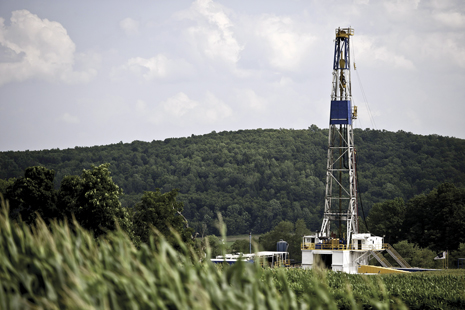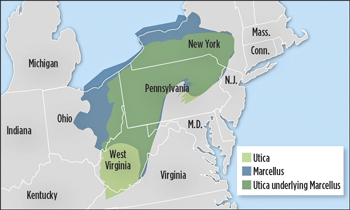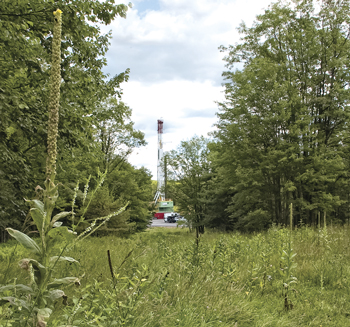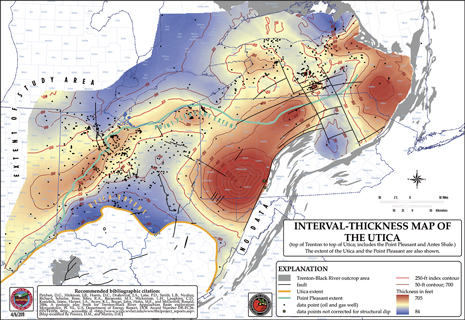RUSSELL WRIGHT, Contributing Editor
 |
| Chesapeake rig drilling in the Marcellus shale, in partnership with Statoil. Photo: Helge Hansen/Statoil. |
|
As of March 2012, nearly 12,000 well permits had been issued in Pennsylvania, where the majority of Marcellus shale development is concentrated. More than 80% of these permits were horizontal. In West Virginia, natural gas drillers have completed nearly 1,600 Marcellus wells since 2006, with another 1,273 wells still in development.
Despite the boom in activity, low natural gas prices have producers that operate in dry gas areas rethinking their immediate plans. Many have curtailed drilling, awaiting better gas prices, while others are refocusing effort to wet gas areas.
Meanwhile, the Utica shale underlies much of the same territory as the Marcellus, but a few thousand feet deeper. It has recently seen expanded exploration in eastern Ohio and Pennsylvania, where it is around 8,000 ft deep. In 2011, drilling and permits, in the Ohio portion reached record highs.
MARCELLUS GEOLOGICAL COMPOSITION
The Marcellus shale, named for where it outcrops near Marcellus, New York, covers much of the Appalachian basin. The shale’s extensive natural gas reserves are especially attractive because of their proximity to markets along the U.S. East Coast. The Devonian age Marcellus is divided into several sub-groups, with black shale being the dominant lithology. Lighter shales and interbedded limestone layers are also present. In the U.S., the Marcellus shale ranges from New York to northern and western Pennsylvania, eastern Ohio, western Maryland throughout most of West Virginia and into extreme western Virginia.
Marcellus thickness ranges from up to 200 ft in West Virginia to 790 ft in extreme eastern Pennsylvania. It thins to the west, caused by decreasing grain size in the clastic deposits that entered the basin from the east, and finally pinched out where deposition was limited by the Cincinnati Arch.
Impervious limestone layers above and below the Marcellus trapped natural gas in the formation. Gas was formed by thermogenic decomposition of organic materials in the sediments under the high temperature and pressure generated after the formation’s burial. Most of the gas is contained in pore spaces of the shale.
INCREASING RESERVE ESTIMATES
In 2002, the United States Geological Survey (USGS) estimated that the Marcellus contained 1.9 Tcf of technically recoverable natural gas. In April 2009, the U.S. Department of Energy estimated the Marcellus to contain 262 Tcf of recoverable gas, Fig. 1. In 2008, Terry Engelder, a Pennsylvania State University geosciences professor, called his estimate of 170 Tcf of recoverable gas conservative. Based on drilling results, he later increased his estimate to 363 Tcf of recoverable gas.
 |
| Fig. 1. Resource estimates indicate the Devonian-age Marcellus shale is the largest exploration play in the eastern United States. |
|
OPERATOR ACTIVITY
Despite the shift in drilling from dry gas to liquids, a number of production records have been set in the Marcellus shale over the last year. Operators have been able to increase net sales volumes, while bringing a number of backlogged wells to production.
Range Resources pioneered the Marcellus shale play in 2004 with the successful drilling of a vertical well, the Renz 1. A significant portion of Range’s acreage (within Pennsylvania, W. Virginia and Ohio) also offers the benefit of natural gas potential from the Upper Devonian and Utica shale formations that lie above and below. In 2012, Range will be directing 86% of its capital budget toward development drilling in the region.
Range has ramped up production from the area rapidly, reaching its exit rate goals in 2009 of 100 net MMcfged, 200 net MMcfged in 2010 and 400 MMcfged in 2011. The next goal is to exit 2012 at 600 MMcfged.
In southwestern Pennsylvania, Range’s initial estimated ultimate recovery (EUR) when it began drilling horizontal wells in 2007 was 3 Bcfe. With improved techniques, recent wells in the area now have EURs of 5.9 Bcfe with 3,000-ft laterals and 10-stage fracs.
In the “super-rich” area in southwestern Pennsylvania (west of the area where most of its wells have been drilled), Range drilled eight wells during the past year-and-a half. During first-quarter 2011, 28 horizontal wells were brought online in southwestern Pennsylvania, all of which are located in the wet area of the play. Results indicate natural gas that contains a higher BTU content, or “super-rich.”
Although Range’s focus has been on the Marcellus, it also targets additional formations in the Upper Devonian and Utica shales. Range has drilled two successful wet Upper Devonian wells, with the best estimated to recover 4.7 Bcfe. Two wells are planned in the “super-rich” area of the Upper Devonian for 2012.
Flow-back was recently commenced on a well at the edge of the super-rich area. Peak one-day production was 108 bpd of condensate, 501 bpd of NGLs, and 7.1 MMcfgd. When ethane is extracted, it is estimated that the well would make 6 MMcfgd and over 1,300 blpd.
During first-quarter 2012, Range’s first Upper Devonian test in the super-rich area was drilled and completed. A second test in the super-rich area is drilling. Preliminary analysis of rotary sidewall cores was very encouraging from both wells.
Also during first-quarter 2012, 28 horizontal wells were brought online in southwestern Pennsylvania, all of which are located in the wet area of the play. Initial 24-hour production rates of the new wells averaged 6.6 MMcfged and 252 bpd of NGLs and condensate.
Due to limitations of the production facilities, many of the 28 newly connected wells produce at constrained rates. Three wells were producing at a combined rate of 45 MMcfged. Three additional wells on the same pad were turned to sales, with total production now at about 75 MMcfged. At first quarter’s end, in southwestern Pennsylvania, there were 57 Marcellus wells waiting on completion and 43 wells waiting on pipeline.
During the first quarter, 10 horizontal wells were drilled in northeastern Pennsylvania, and five horizontals were turned to sales in Lycoming County. Four wells had outstanding 24-hour test rates. Average test rate for these wells was 22 MMcfgd.
Current Marcellus production is some 460 MMcfged, with roughly 80% coming from the liquid-rich area. Range is on track to meet its 600-MMcfged net production target by year-end 2012.
Anadarko Petroleum Corp. The company’s Marcellus properties set a weekly production record during December 2011 of 850 MMcfgd from 210 (gross) producing wells, while also reaching an operated production record of 313 MMcfgd. Net sales volumes for the quarter increased more than 260% from the same period in 2010 and exceeded the prior quarter by almost 40%. The 2011 gross exit rate of approximately 860 MMcfgd was 160% above the 2010 gross exit rate of 330 MMcfgd.
During 2011, the company spudded 133 operated wells with an average seven rigs, Fig. 2. During second-quarter 2011, drilling achieved a quarter-over-quarter reduction in cycle times from 26.8 days to 19.6 days from spud.
 |
| Fig. 2. Anadarko Petroleum Corp. spudded 29 operated Marcellus wells during fourth-quarter 2011 using seven rigs. The company spudded 43 non-operated wells with 11 rigs. Photo: Anadarko Petroleum Corp. |
|
Anadarko has increased the EUR per well to 8 Bcf, from its earlier range of 4.0 to 6.0 Bcf per well. The company achieved the milestone of 1.0 Bcfgd of gross production during first-quarter 2010, and an operated-production record of 370 MMcfgd. Net sales volumes for the quarter increased by more than 150% over the same period in 2011, and increased by 30% over the fourth quarter of 2011.
Cabot Oil & Gas Corp. Despite the dynamics in the commodity fuels markets, Cabot claims it is well-positioned with its Marcellus holdings. The company will continue to focus efforts on growing its liquids production, and will manage expenditures around anticipated cash flow.
During its fourth consecutive year of drilling horizontal wells in the Marcellus shale during 2011, Cabot drilled 64.7 net wells and completed 904 frac stages, compared to 529 stages in 2010. Twelve wells were put onstream in 2011 that had 24-hr initial production rates of over 20 MMcfgd. The planned completed per-well cost for 2012 is about $6 million.
Each year, Cabot has been able to expand production from the previous year. At year-end 2010, gas production hit 236 MMcfgd, but by year-end 2011 rates had risen to 600 MMcfgd.
Southwestern Energy had 186,893 net acres in Pennsylvania at year-end 2011. As of May 3, 2012, Southwestern had participated in 94 operated horizontal wells in northeastern Pennsylvania, of which 24 were producing on March 31, 2012. Net area production was 9.3 Bcfg in first-quarter 2012, compared to 2.8 Bcfg in first-quarter 2011. The company’s gross operated production from the area was about 122 MMcfgd, limited by high line pressures.
In 2012, Southwestern will invest $526 million and end the year with four operated rigs and participate in 80 to 85 gross wells, all of which it will operate. For 2012, estimated production from the Marcellus will be 60 to 65 Bcfg
Carrizo Oil & Gas Inc. owns a 40% working interest in some 113,000 gross Marcellus acres in Pennsylvania. In 2012, the company plans to bring on production its backlog of 29 wells, in addition to a number of wells to be drilled in 2012. After investing over $45 million, net, in 2011, Carrizo expects to invest around $62 million, net, in the Marcellus Shale in 2012.
Carrizo operated two rigs in northeastern Pennsylvania during 2011, drilling from multi-well pads. In late October, following completion of the Laser pipeline, the company brought its first two wells on production, followed soon after by a three-well pad.
EQT Production Corp. With some 520,000 acres and 2.9 Tcfe of proved gas reserves, EQT is a leading Marcellus player. EQT drilled 105 Marcellus wells in 2011. In light of lower natural gas prices and the resultant reduction in projected cash flow, the company decided in January 2012 to suspend development in the Huron indefinitely, in favor of investing in its higher-return Marcellus play.
Gross wells drilled have risen from 46 in 2009 to 90 in 2010 and 105 in 2011. Capital expenditures for development wells have also risen from $118 million to $436 million and $686 million, respectively. This year, capital expenditures for well development (primarily drilling) are expected to reach $1.055 billion to support the drilling of about 158 gross wells.
Talisman Energy’s Marcellus shale play is in New York and Pennsylvania, with its main focus in the latter state. The company exited 2011 with fourth-quarter production averaging 486 MMcfgd, up from 272 MMcfgd in fourth-quarter 2010. Significant improvements were made in the cost per frac stage.
Talisman has no immediate plans to drill in New York because of the state’s environmental assessment procedures and regulations. And, due to current gas prices, Talisman will reduce activity to between five and seven rigs in 2012.
The company achieved record production of about 485 MMcfgd in fourth-quarter 2011. Even with five rigs, it expects to be able to hold 2012 production in the play to about 500 MMcfgd.
CONSOL Energy. Having acquired Dominion Resources’ E&P business, CONSOL has access to over 3.7 Tcf of proved gas reserves, including coalbed methane and shale beds. Its properties in Pennsylvania, West Virginia and New York totaled about 361,000 net Marcellus acres at year-end 2011. Also last year, CONSOL entered into a JV with Noble Energy regarding its Marcellus assets in West Virginia and Pennsylvania. The JV holds 628,000 net acres in those states, as well as CONSOL-owned producing Marcellus wells.
Ultra Petroleum is focusing on emerging Marcellus shale opportunities in Pennsylvania. As of year-end 2011, Ultra’s Marcellus position consists of 500,000 gross acres of leases across five counties (Potter, Tioga, Clinton, Centre and Lycoming) in north-central Pennsylvania. The area has the potential for 2,500 future net wells and 9.5 Tcfge of net resource potential. Ultra has 100% working interest in almost 60,000 acres in Tioga and Potter counties.
In 2008, Ultra planted $35 million in seed capital, drilling 18 vertical wells to evaluate the acreage. With encouraging well data analysis, Ultra and its partners escalated activity. In 2009, Ultra spent $135 million, commencing a 30-plus horizontal-well drilling program, then more than doubled that to over $400 million in 2010.
Penn Virginia Corp. At year-end 2011, the company had about 1.0 million net acres in Appalachia, and is focused on exploring the Marcellus in Pennsylvania. Penn Virginia also has reserves and production from a variety of unconventional, coalbed methane and royalty properties in West Virginia, Virginia and Kentucky. The company estimates 145.5 Bcf of proved gas reserves in Appalachia, of which 74% are developed. This includes 39.8 Bcfg proved in the Marcellus, of which 16% are developed. Penn Virginia has an estimated drilling inventory of about 230 Marcellus horizontal drilling locations in Potter and Tioga Counties. The company expects reserves and production will be almost entirely dry gas.
ExxonMobil has hit the one-year anniversary of the merger with XTO. The company completed mergers with Phillips Resources, Inc., and TWP Inc., which added a combined 317,000 acres of leasehold in the Marcellus, bringing ExxonMobil to over 700,000 acres in the huge gas play. As a result, a new division based in Pittsburgh was created to manage this key high-growth focus area.
EOG Resources. The company continued development of its Pennsylvania Marcellus properties during 2011 by drilling 27 net wells. EOG’s net gas output was 33 MMcfd during 2011, significantly higher than the 12 MMcfgd in 2010.
Chevron. With the acquisition of Atlas Energy in 2011, Chevron became a producer of natural gas from U.S. shales. The firm is one of the largest leaseholders in Pennsylvania, with more than 700,000 net acres of leases in the Marcellus.
Atlas Energy LP. At year-end 2011, Atlas had an interest in some 221 wells in Pennsylvania, of which 14 were horizontal. An additional 24 wells (eight vertical, 16 horizontal) have been completed and are scheduled to go on-line during first-half 2012. Also at year-end, the company had drilled 11 Marcellus wells, and planned to drill an additional two Marcellus wells during first-quarter 2012 in West Virginia.
PERMITTING AT RECORD HIGH IN UTICA
The Utica shale, named for the city of Utica, New York, where it outcrops, underlies much of New York, Pennsylvania, Ohio and West Virginia. It also extends into Maryland, Tennessee, Kentucky and Virginia, and adjacent parts of Ontario and Quebec. The Utica recently became an exploration focus in eastern Ohio and Pennsylvania, where it is around 8,000 ft deep, Fig. 3. Permits for drilling in Ohio during 2011 reached record highs. The formation can be as thick as 1,000 ft, but it thins to 70 ft toward the basin margins. Most exploration and development of the Utica is in Ohio, but is expected to spread into Pennsylvania.
 |
| Fig. 3. While limited production has occurred in the Utica up to this point, thickness and widespread geographical extent indicate it may also have great oil and gas potential. Source: Ohio Department of Natural Resources, Division of Geological Survey |
|
Ohio released the first Utica development results during 2011. Five wells drilled by Chesapeake in Carroll and Harrison counties began producing low rates of oil, but with strong gas output, Together, the wells produced between 53 and 206 days in 2011,with total production amounting to 43,513 bbl of oil and 2.5 Bcfg. The best well in Harrison County had 300 times more daily production than the average Ohio vertical gas well.
UTICA OPERATOR ACTIVITY
Some expect the Utica to be the next major U.S. shale play, and producers have flocked to the region. BP has leased 84,000 acres in Trumbull County, Ohio. Chesapeake is the Utica’s largest leaseholder and has permits to drill 79 new wells.
Anadarko Petroleum Corp. has drilled and is producing three wells. The most recent, Brookfield A-3H in Noble County, produced 9,500 bbl of oil and 12 MMcf of high-BTU gas during its first 20 days on-line. The Spencer A-1H and Spencer A-5H wells, in Guernsey County, have cumulatively produced a combined 20,000 bbl of light-gravity crude oil and 37 MMcf of liquids-rich gas in just under two months on-line. All three wells were horizontally drilled to a vertical depth of about 6,500 ft.
CONSOL is exploring 200,000 acres in Ohio. Their drilling schedule includes operations in Tuscarawas, Noble, Portage, Mahoning and Trumbull counties in the eastern part of the state.
Atlas Energy LP has an interest in approximately 2,100 wells in Ohio and operates three field offices, which it intends to use for future Utica shale exploration.
CASE STUDY: TECHNOLOGY ADVANCES
With an estimated 262 Tcf of recoverable gas, the Middle Devonian Marcellus shale has become one of the main unconventional shale gas targets in the U.S.
The challenge. The Marcellus is a challenging target, due to its depth (4,000 to 8,500 ft), making it cost-intensive to develop. In addition, operators working in the Marcellus have had to contend with public challenges to hydraulic fracturing, prompting them to look for technologies to make this process more efficient and environmentally sensitive.
There are two main methods of multi-stage fracing: cemented liner, “plug-and-perf” and open-hole fracing systems. Although both methods have the same goal of increasing access to the reservoir through the induction of fractures along the entire length of the horizontal wellbore, they have significant operational differences.
The solution. The Packers Plus StackFRAC system was introduced in 2001, to make multi-stage fracing more efficient, both in terms of time and cost, as well as repeatable and reliable. StackFRAC is an open-hole, multi-stage fracturing system that uses external, hydraulically set, mechanical RockSEAL II packers, instead of cement, to isolate wellbore sections, and FracPORT sleeves to create openings in-between the packers for fracture treatment. Size-specific actuation balls are injected into the system to allow for hydraulic opening of the FracPORT sleeves. The balls create internal isolation from stage to stage, eliminating the need for bridge plugs.
Results. The major advantage of this system is that all fracture treatments can be performed in a single, continuous pumping operation, without the need for a drilling rig or wireline/coiled tubing services. This not only saves time and costs, but also reduces the number of HSE high-risk operations. The continuous operation also allows the well to be immediately flowed back, and production brought on-line as soon as fracturing is complete.
Another benefit of StackFRAC completions is that they are more environmentally sensitive, because less frac fluid is used. The cemented liner, plug-and-perf method requires bridge plugs to be pumped down the tubing, which entails flushing the entire wellbore to remove proppant from the previous stage. This excess fluid can be detrimental to fracture conductivity near the wellbore, by pushing the previous stage’s proppant further in the reservoir, resulting in overdisplacement. By using less frac fluid, the system reduces the amount of water required, decreasing the environmental impact and saving up-front water costs, as well as costs to treat and dispose of produced fluids.
An unexpected benefit of StackFRAC completions noted by operators has been a dramatic reduction of excessive fracture initiation pressure, as high fracture gradients are a characteristic of shale. On earlier cemented liner treatments, it was common that some frac treatments could not be initiated on some stages, due simply to excessively high breakdown pressures. Because fractures can initiate anywhere within the open-hole section of each isolated stage, the fracture will take the path of least resistance – where the breakdown pressure is the lowest.
As of September 2010, over 5,000 StackFRAC systems have been run worldwide in a variety of formations, both on and offshore. Over 20 systems have been run in the Marcellus, for more than 150 stages. Over 700 systems have been run in the Devonian shale. 
|






